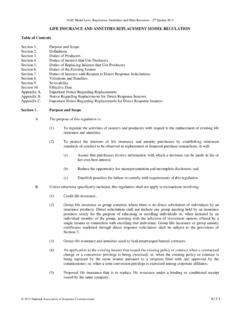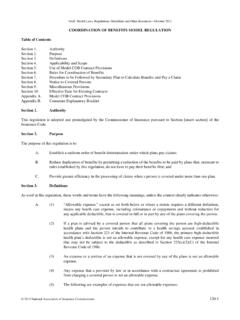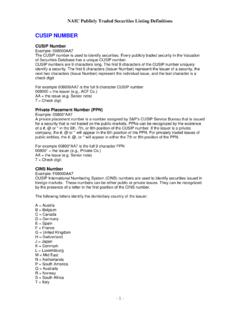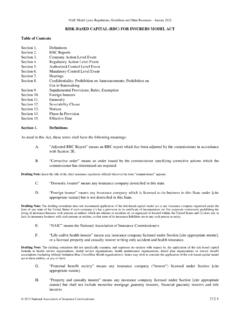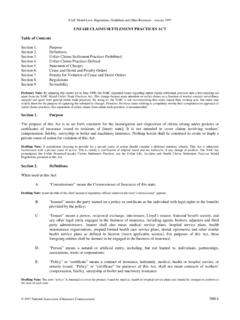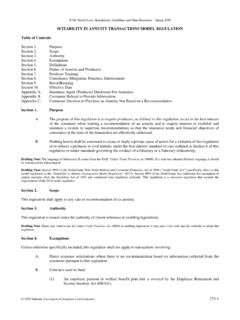Transcription of Collateralized Loan Obligations (CLOs) Primer
1 The NAIC s Capital Markets Bureau monitors developments in the capital markets globally and analyzes their potential impact on the investment portfolios of insurance companies. Please see the Capital Markets Bureau website at INDEX. Collateralized Loan Obligations (CLOs) Primer Analyst: Jennifer Johnson Executive Summary Brief Background on CLOs, CBOs and CDOs The structured finance securities market not only includes CLOs, but also Collateralized bond Obligations (CBOs) and Collateralized debt Obligations (CDOs).
2 Note that since the financial crisis, CLOs have continued with new issuance, while CBOs and CDOs have almost disappeared. CBOs are structured finance securities that are Collateralized by a pool of bonds, often high-yield corporate bonds, investment grade bonds, or emerging market sovereign and/or corporate bonds. CDOs include transactions that are Collateralized by trust preferred securities (TruPS CDOs), asset-backed securities CLOs are structured finance securities Collateralized predominantly by a pool of below investment grade, first lien, senior secured, syndicated bank loans, with smaller allocations to other types of investments such as middle market loans and second lien loans.
3 CLO debt issued to investors consists of several tranches, or layers, with different payment priorities and, in turn, differing credit quality and credit ratings. The senior-most tranche is the most-protected and, therefore, has the highest credit quality and the lowest coupon. CLOs have structural features that serve as protection for the debt and equity investors, such as overcollateralization and interest coverage tests. Due in part to sound structural features, a low default rate environment for bank loans and prudent investment management, CLOs were considered survivors of the financial crisis.
4 While they are historically less than 1% of total insurer cash and invested assets, CLOs offer an attractive yield alternative to traditional bond investments. 2 (ABS CDOs), commercial real estate/commercial-mortgage backed securities (CRE/CMBS CDOs), residential-mortgage backed securities (RMBS CDOs), and even other CDOs or CLOs (CDO-squareds). As discussed in this Primer , CLOs are Collateralized by broadly syndicated bank loans (BSLs), as well as middle market loans. For all aforementioned CLOs, CBOs and CDOs, principal and interest income earned on the underlying pool of assets is used to pay periodic interest to investors (most often, semi-annually or quarterly) and principal when due at maturity (on average, 10 years).
5 The first CBO and CLO were brought to market in the late 1980s, and as the market evolved, CDOs began to appear. Unlike CLOs, CDOs and CBOs had shown to be volatile asset types during the recent financial crisis. This was due in part to the volatility of the underlying commercial and residential mortgage loans. In particular, RMBS CDOs had undergone severe and multiple ratings downgrades by the three major nationally recognized statistical ratings organizations (NRSROs) Standard & Poor s Global Ratings, Fitch Ratings and Moody s Investors Service due to the negative impact of delinquent, defaulted and foreclosed residential mortgage loans held in the underlying RMBS pools, especially those containing subprime and adjustable rate mortgages.
6 CLOs, however, did not experience this trend, due in part to the underlying bank loans and the ability of the capital structure to withstand certain structural performance measures (relative to credit enhancement levels and interest coverage). As a result, CLOs were deemed the survivors of the financial crisis. The Composition of a CLO Capital Structure Chart 1 shows the capital structure of an arbitrage CLO transaction. Investor proceeds are used to purchase a portfolio of leveraged bank loans, whose principal and interest are used to pay debt service to the noteholders, with any remaining amounts paid out to the equity investors.
7 The transaction is referred to as arbitrage because it aims to capture the excess spread between the portfolio of leveraged bank loans (assets) and classes of CLO debt (liabilities), with the equity investors receiving any excess cash flows after the debt investors are paid in full. Arbitrage CLOs account for 90-95% of CLO transactions. The CLO is structured as a special-purpose vehicle (SPV), and sometimes the CLO manager is an equity holder. However, this is not always the case, and it is not a requirement.
8 Chart 1: 3 About 5-10% of CLO transactions include balance sheet CLOs, whereby the mechanics are the same as arbitrage CLOs, but they differ in that balance sheet CLOs are structured primarily as a funding source for the issuer (usually a bank or specialty finance company). With balance sheet CLOs, the issuer securitizes the bank loans (middle market or broadly syndicated) off its balance sheet into an SPV, for the purpose of raising capital, and it typically retains the equity tranche. Whether arbitrage or balance sheet, the CLO capital structure is comprised of CLO tranches (or CLO debt) plus an equity tranche, which serves as the first loss position.
9 The tranches range from senior to subordinated; the more subordinated the bonds, the lower the credit quality, and the more required credit enhancement ( , the ratio of the principal value of the collateral to the principal value of the CLO debt). As such, senior tranches are rated higher (investment grade) than subordinated tranches (below investment grade) by the NRSROs, such as Standard & Poor s and Moody s Investors Service. The equity tranche is typically unrated. Principal and interest on the CLO debt and returns to equity holders are paid in accordance with waterfall instructions that are included in legal documents, such as the trust indenture.
10 CLO tranches tend to offer a higher spread for comparable credit risk, as they are typically priced at a spread (in basis points) above the three-month London Interbank Offered Rate (LIBOR). The CLO structure also benefits from certain structural features such as credit enhancement. To ensure sufficient credit enhancement supports the transaction, the CLO capital structure is subject to overcollateralization (O/C) tests at each tranche level, whereby the principal value of the underlying portfolio must be greater than the principal value of the outstanding tranches.
